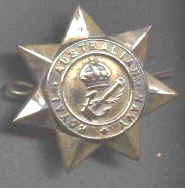 |
Cape Spada
|
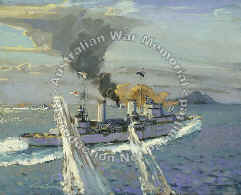
|
|
19 July 1940
|
|
HMAS Sydney off Cape Spada >>
|
The action took place off Cape Spada,
the tongue of land which, with Agria Grabusa a little to the westward,
forms the north-western extremity of Crete and is that island's
furthermost projection into the Aegean Sea. The lure of the enemy
submarine had taken the British ships north of Crete. They were on a
hunting sweep, Sydney and Havoc away to the north, controlling the
approaches to the Gulf of Athens, and the other four destroyers within
sight of the Cretan coast. The day broke fine on July 19, still and
calm, with a pride of the morning haze that the rising sun touched to
life as a silver sea and sky. The southern destroyers were westward of
Cape Spada at this time, and to the north-westward of Agria Grabusa,
steering a westerly course.
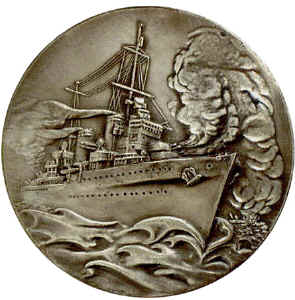 |
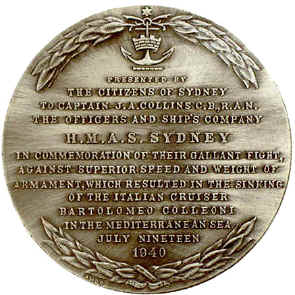 |
| PRESENTED
BY THE CITIZENS OF SYDNEY TO CAPTAIN J.A.COLLINS CB.,R.A.N. THE
OFFICERS AND SHIP'S COMPANY IN COMMEMORATION OF THEIR GALLANT FIGHT
AGAINST SUPERIOR SPEED AND WEIGHT OF ARMAMENT, WHICH RESULTED IN THE
SINKING OF THE ITALIAN CRUISER BARTOLOMEO COLLEONI IN THE
MEDITERRANEAN SEA JULY NINETEEN 1940.
|
Dawn action stations were over, the sun
having risen astern of the ships, and, as an observer in Hyperion put
it:
'Soon the smell of frying bacon
floated up the bridge voice pipes, and those on watch glanced at the
clock, impatient for relief. "Two cruisers on the starboard bow,
sir!" said the starboard bridge lookout, adding convincingly, but
as an afterthought-"and they're Italian, too."
It was twenty minutes past seven, and
at once the heart-lifting clanging of alarm bells brought half-clothed
men tumbling up from below. They saw from heeling decks, as the
destroyers turned away under full rudder, two Italian cruisers-
ghost-like, yet clear and in full view-which had come out of the mist
ahead, no more than 10 miles away.
Sydney, some 40 miles to the
northward, received the destroyers' enemy report by wireless at 0733,
and immediately turned south, and started working up to full speed.
To the two Italian cruisers the four
destroyers must have looked easy game. The cruisers had not only the
advantage of weight and range of gunfire, they also had a margin of some
knots speed over the destroyers. Sydney and Havoc, whose presence was
unknown to the Italians, were some miles away, and it was going to be
what would, in the circumstances, be a considerable time before they
could throw their weight in to even things up a bit. Commander Nicolson,
in charge of the destroyer division in Hyperion, decided to play the
Italians carefully in the right direction, so as to shorten both space
and time as much as possible. He led off, therefore, to the northward
under fire from the cruisers, which took up the chase with mounting
confidence, themselves being out of range of the destroyers' guns. The
destroyers, for their part, could only, while conforming to the general
line of advance, watch and dodge the fall of the Italian shot, a form of
amusement described by a destroyer participant as "an unpleasant
pastime".
Meanwhile Sydney and Havoc were
interested auditors of the goings on ahead of them, for Hyperion kept
them advised by wireless of the progress of events. Hyperion's
"smell of frying bacon" may have been wasted on the Aegean
air, but Sydney had time to send hands to breakfast before action was
sounded at O8I5. She sighted the enemy on the starboard bow at 0826, and
opened fire at 0829.
This was a pleasing sight to the
Hyperion and her consorts. As one of them put it:
At 0829 bridge lookouts in the destroyers-who could still discern
nothing to the northward except the island of Milo, gradually taking
shape over the haze-saw, on the port bow, the orange flashes of the
Sydney's opening salvo, the most welcome sight in the world. She came
rushing to the southward, on the port beam of the Italians, guns
flashing, battle ensigns streaming, and such a smother of foam at bow
and stern that from the destroyers one seemed almost to hear the
high-tensioned scream of the machinery driving her across the water.
At 0835 Sydney's fire appeared to be
effective on the leading Italian, and at 0841 the enemy turned away and
retired south-westwards, and the action developed into a chase, with
Sydney and her five attendant destroyers as the pursuers. The British
force, was tearing through the water almost in line abreast, the
retiring enemy making heavy smoke, so that Sydney had to shift fire as
one or the other target became obscured. It soon became apparent that
the rearmost Italian cruiser-the Bartolomeo Colleoni-was, coming under
very effective fire from the Sydney, which herself suffered her one hit
at 0921, an enemy shell tearing a large hole in the foremost funnel.
There was, only one slight casualty in the whole action, caused on this
occasion by a splinter.
Again the destroyers paint the
picture:
The haze of the morning had now lifted. The sun shone clearly on the
water suddenly becoming a brilliant blue, and the first of the day
breeze whipped the sparkling tops of the little waves and, lifted their
fresh spindrift over the destroyer forecastles. The white wakes, the
bright bunting, the orange flash of cordite and its brown smoke blown
back across the straining grey ships-all in the brilliant light of the
early Aegean forenoon, would have made the scene a delight to any
painter of sea battles.
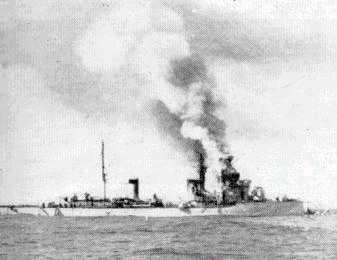
The Bartolomeo Colleoni
It was now seen that the Bartolomeo
Colleoni was damaged to the extent of reducing her speed, and with the
closer range her punishment increased. At 0923 she was observed to be
stopped and apparently out of action, between Cape Spada and the island
of Agria Grabusa. Her consort-the Giovanni Delle Bande Nere-after a
momentary hesitation, abandoned her to her fate and disappeared around
Agria Grabusa, making to the southward at her best speed. Leaving
Hyperion, Ilex and Havoc to finish off Bartolomeo Colleoni, the Sydney
continued the chase with Hasty and Hero, but the Giovanni Delle Bande
Nere had too much speed and drew gradually away in the smoke laden
Mediterranean haze, and the chase was abandoned at 1037.
Meanwhile, the Bartolomeo Colleoni,
torpedoed by Ilex and Hyperion, had rolled over and sunk at 0959, having
previously been abandoned by those of her company not killed in the
battle. Of her complement, 555 were rescued by the destroyers, the
operation being hampered by Italian bombers, who bombed the rescuers.
Their work completed, the British
ships set course for Alexandria, making port safely, after a number of
severe bombing attacks, on the forenoon of July 20. Sydney received an
ovation from the assembled fleet as she steamed up the harbour with the
Australian jack at the fore. The following day His Majesty the King made
Captain Collins a Commander of the Order of the Bath, and, among other
awards to personnel engaged in the action, Commander Nicolson, of Hyperion,
received a bar to his D.S.O.
One of those rescued from the
Bartolomeo Colleoni was her commanding officer, Captain Umberto Narvi.
He was, however, badly wounded, and died in Alexandria aboard a British
Hospital Ship. He was buried in the British military cemetery with full
naval honours, commanding officers, officers, and ratings from British
ships in harbour attending his funeral.
The cruiser Giovanni delle Bande Nere,
although damaged by gunfire, managed to outrun HMAS Sydney and was
believed to have taken refuge at Tobruk. HMS Eagle's Swordfish were
ordered to attack Tobruk and although the cruiser was not present they
nevertheless found and sunk two destroyers.
So ended a notable cruiser duel, an
action similar, in that respect, to the fight between the Emden and the
Sydney's famous predecessor, off Cocos Island in 1914, and with a
similar result.
|
